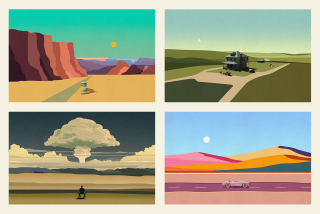Lucien Ballard; Leading Hollywood Cameraman
- Share via
Lucien Ballard, a cinematographer whose camera focused on the panoramic violence endemic to Sam Peckinpah’s Westerns while his earlier efforts included the two-reel comic intimacies of the Three Stooges, has died in an accident near his Indian Wells home, it was learned Tuesday.
His son, Tony Ballard, said his father had been riding his bicycle when he collided with a tractor last Thursday. He was taken to Eisenhower Medical Center in nearby Rancho Mirage and died there Saturday.
Ballard was 84.
Although never singled out for an Academy Award (he was nominated in 1963 for “The Caretakers”), Ballard’s lengthy and varied body of work made him one of the most distinguished of Hollywood’s cameramen.
His credits ranged from Peckinpah’s dark adventure drama “The Wild Bunch” to the Western spoof that brought John Wayne an Oscar, “True Grit.” Both were filmed in 1969, and many felt they canceled each other out when members of the motion picture academy selected an outstanding cameraman the following year.
But Ballard did not limit his work to commercially viable films. He was the “eye” behind such cult classics as “A Kiss Before Dying,” “The Killing” and “Al Capone.”
The Oklahoma native who was of Cherokee heritage and whose chiseled features made him a candidate for a role in front of the camera said he always had a policy of chasing pictures that “have a chance of coming out with something good.”
Ballard had intended to be in the lumber business until he dated a script girl who took him to a three-day party hosted by Clara Bow.
That glamorous weekend sent him to Paramount studios where he found a job as a film cutter. His subsequent assignment as an assistant cameraman came to the attention of Josef von Sternberg, the first of such legendary directors as Henry Hathaway, Stanley Kubrick, Dorothy Arzner and Peckinpah who would use Ballard’s visions over the years.
Von Sternberg used him on “Morocco” in 1930, an early Marlene Dietrich picture. The resultant high-contrast images became Ballard’s trademark.
With Von Sternberg he also did “The Devil Is a Woman” and “Crime and Punishment” before settling down to work on a run of long-forgotten films. He made “Lone Wolf” in Paris in the late 1930s and several two-reel comedies, many of them featuring the Three Stooges and Charlie Chase.
By then he was filming for Columbia and the studio--which had fallen on hard times--was demanding quantity over quality.
He moved to 20th-Century Fox in 1944 to film “The Lodger” and a year later married the co-star of that retelling of the Jack the Ripper mystery, Merle Oberon. They divorced in 1949.
He filmed “The Killing” for Kubrick in 1956, and that seemed to revitalize his creativity. He came back to full prominence after his initial teaming with Peckinpah in “Ride the High Country” in 1962. That movie is considered one of the most beautifully filmed of all Hollywood’s countless Westerns.
Other highlights of Ballard’s more than 100-film, four-decade career included “Craig’s Wife,” “Orchestra Wives,” “Tonight We Raid Calais,” “Night Song,” “The House on Telegraph Hill,” “Prince Valiant,” “Anna Lucasta” and “Susan Slade.”
The last of his pictures was “Rabbit Test,” made in the 1970s, a decade in which he also filmed “What’s the Matter With Helen,” “Junior Bonner,” “Breakout” and Mikey and Nicky.”
A widower, Ballard is survived by sons Tony and Chris, two brothers and a grandchild. At his request, there will be no services.
More to Read
The biggest entertainment stories
Get our big stories about Hollywood, film, television, music, arts, culture and more right in your inbox as soon as they publish.
You may occasionally receive promotional content from the Los Angeles Times.










